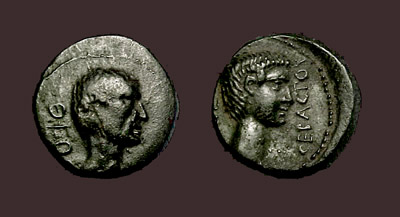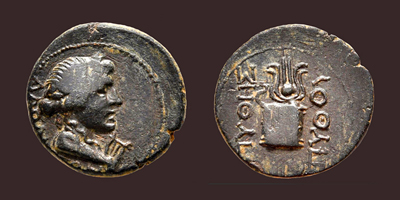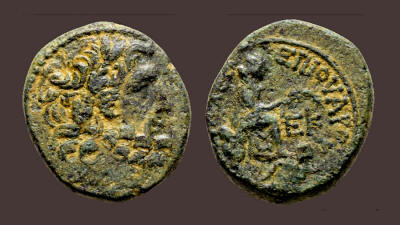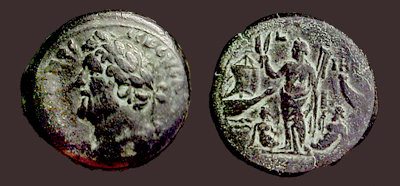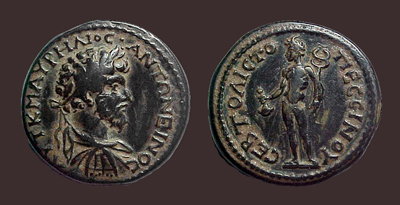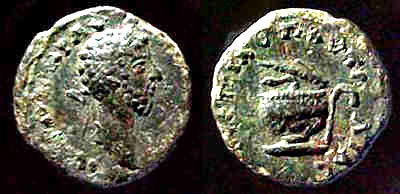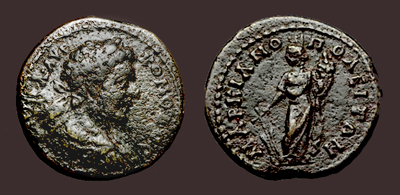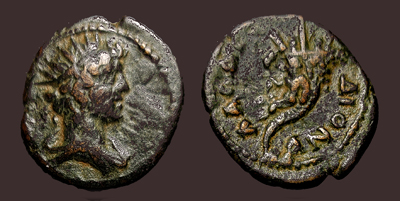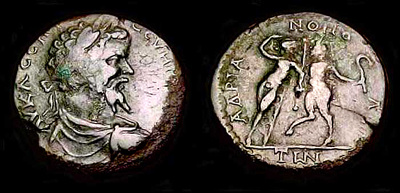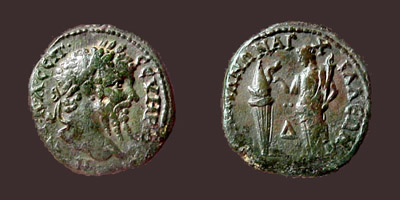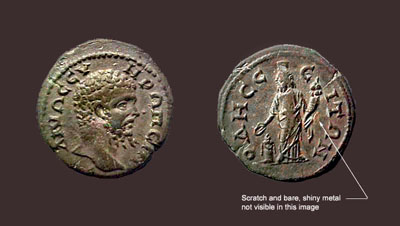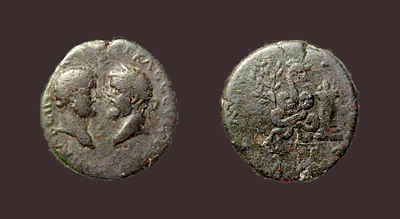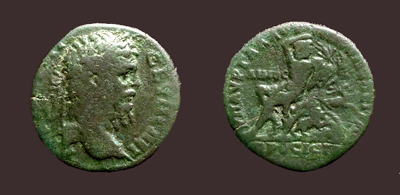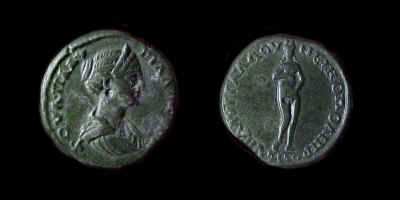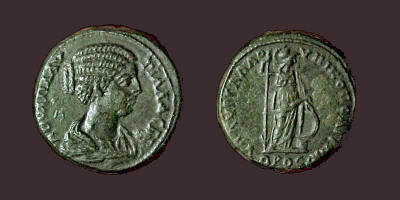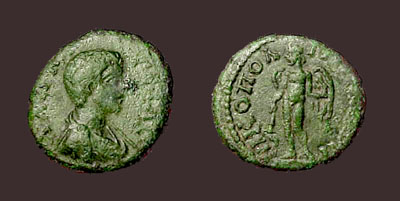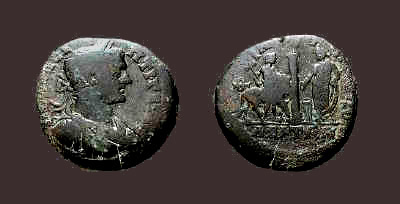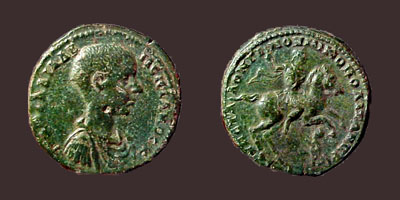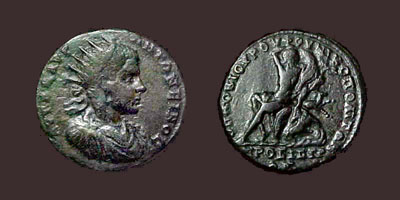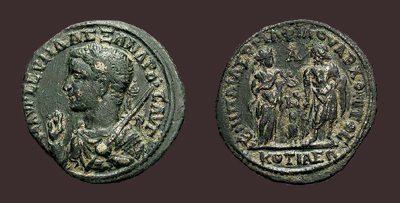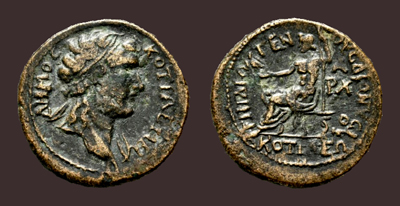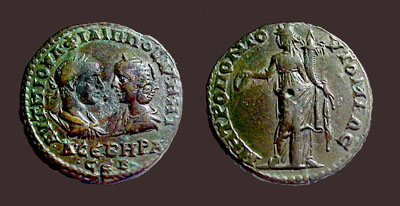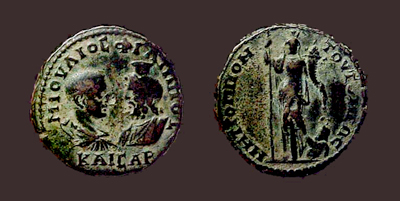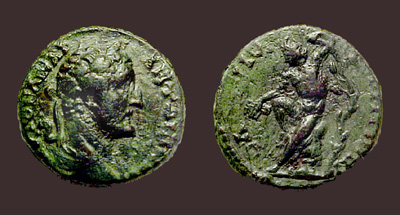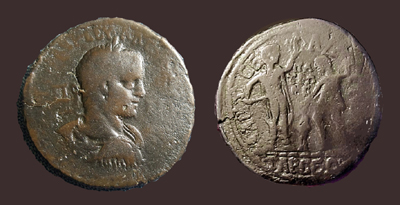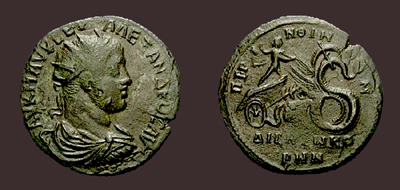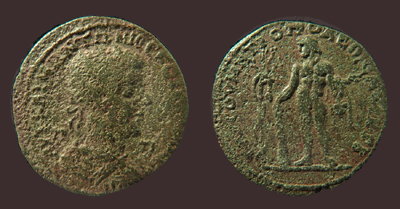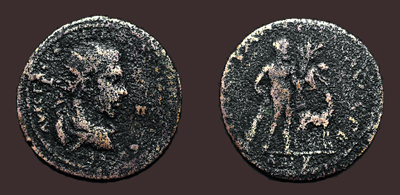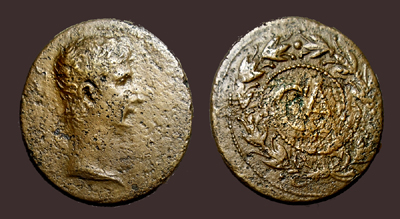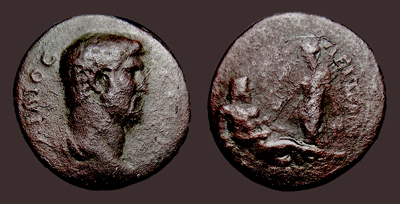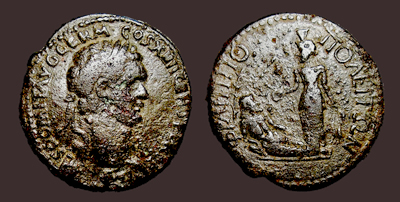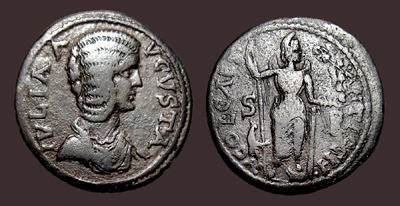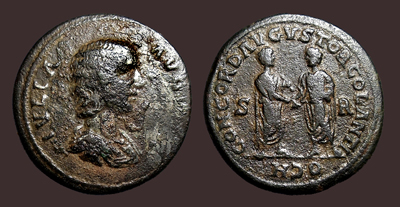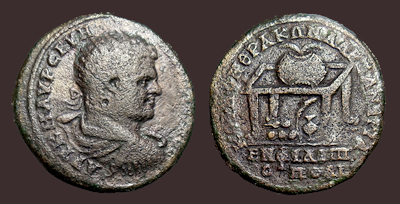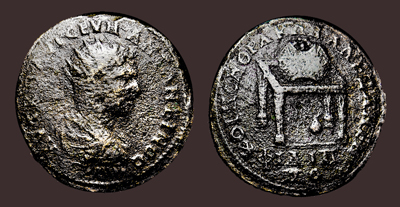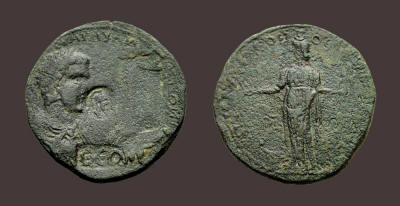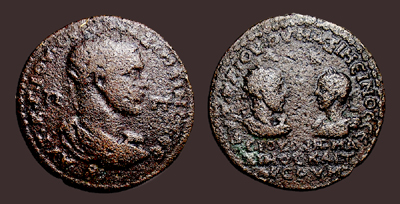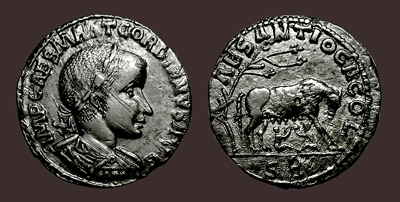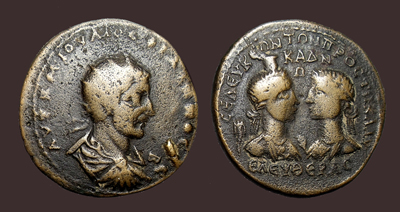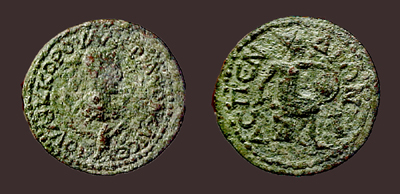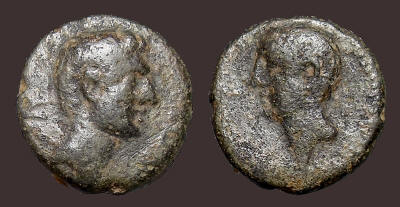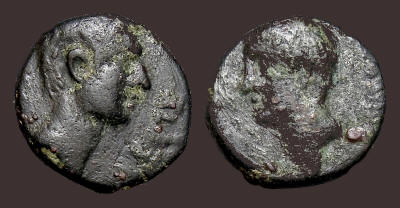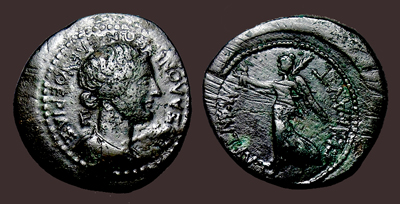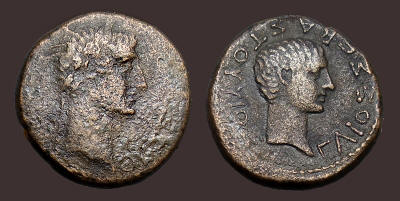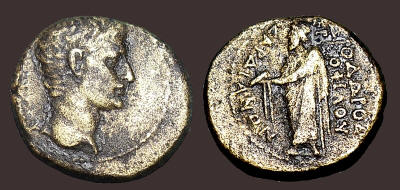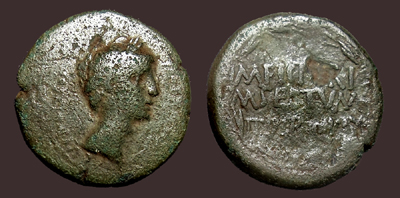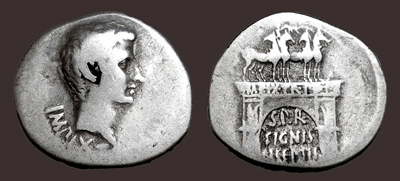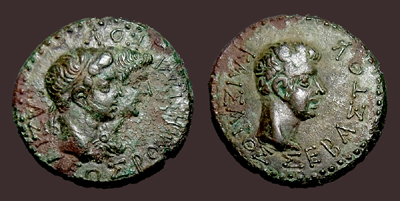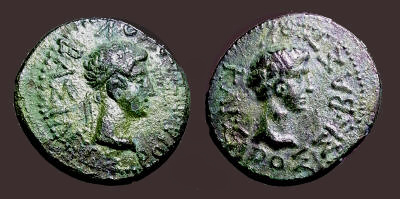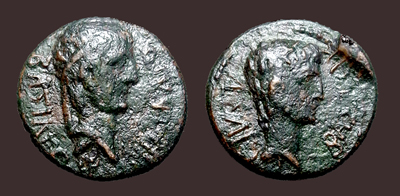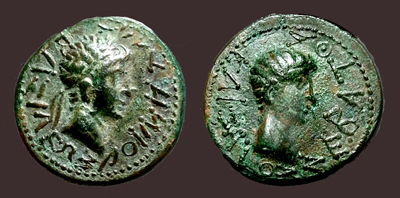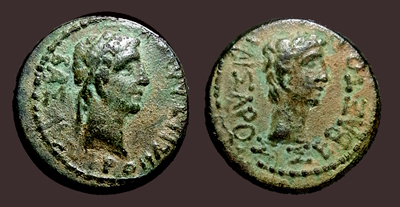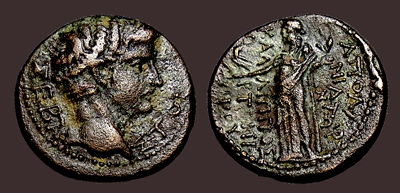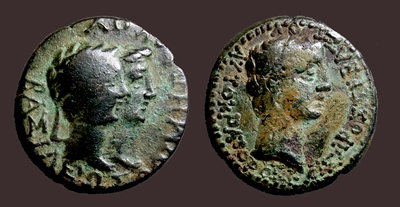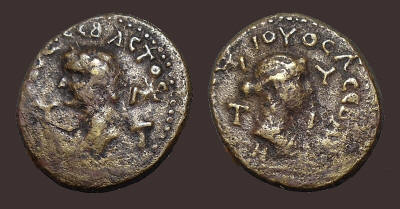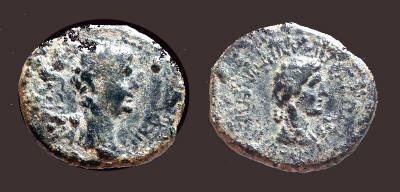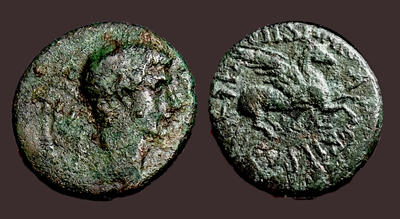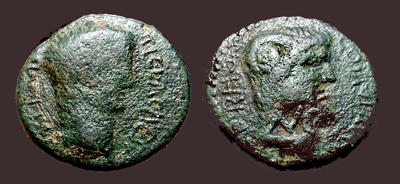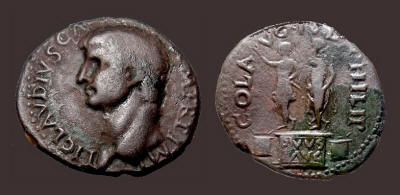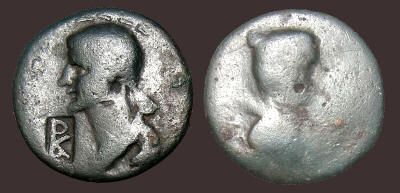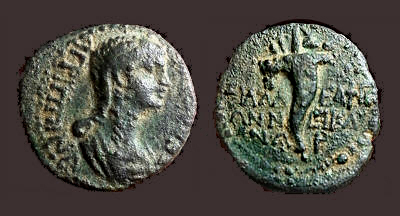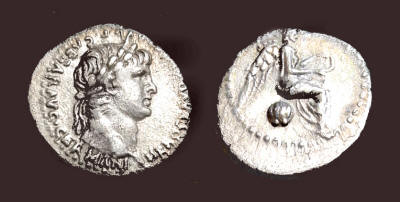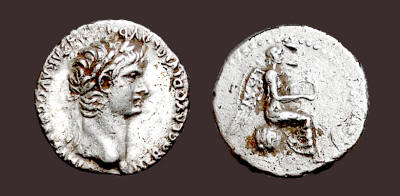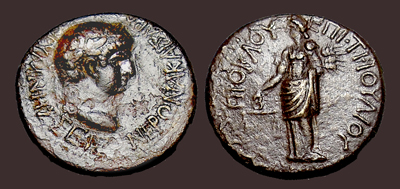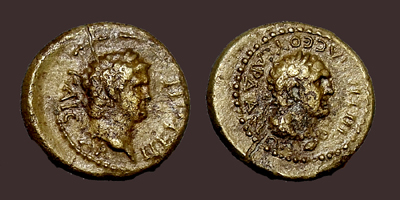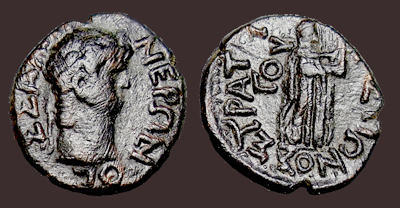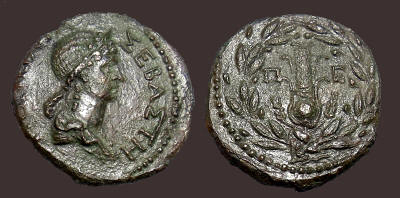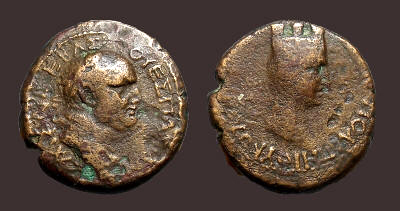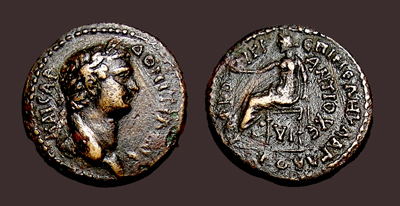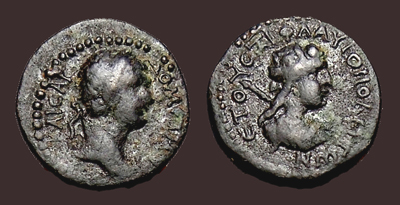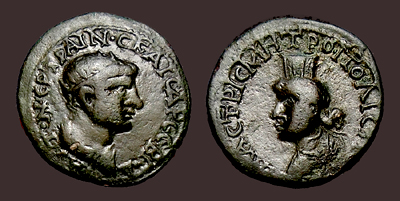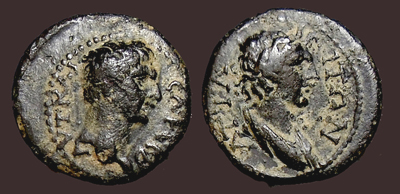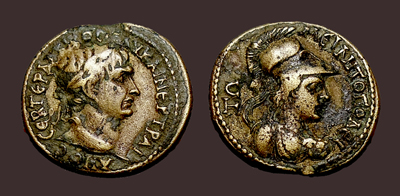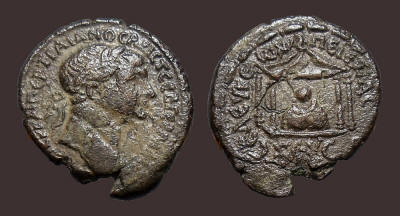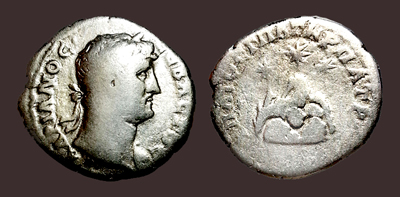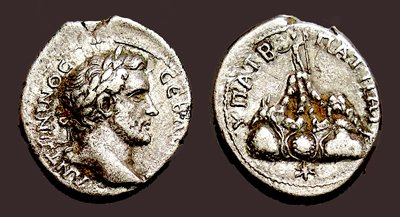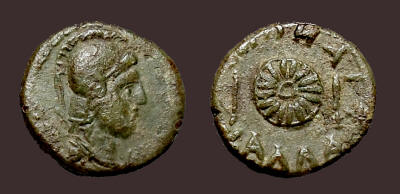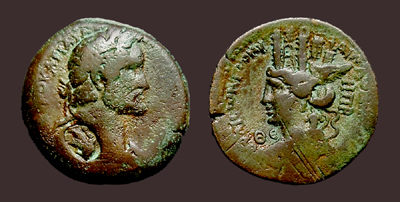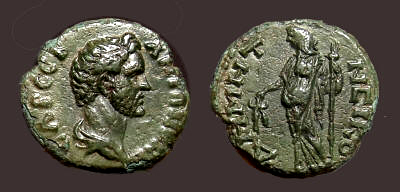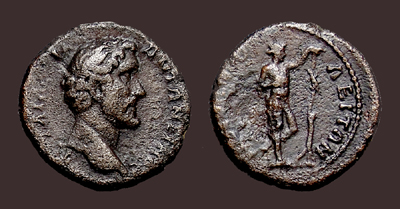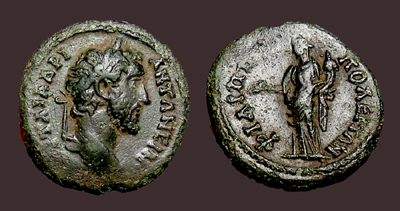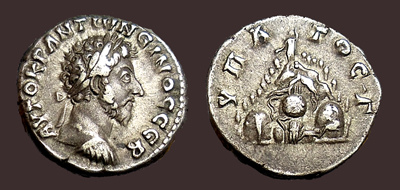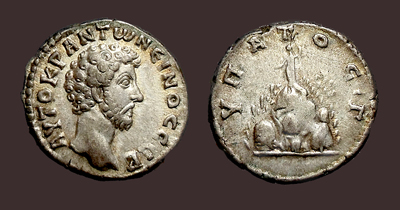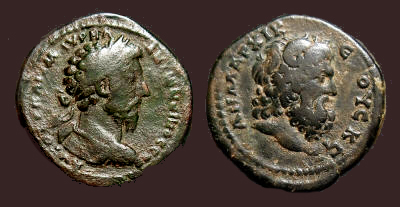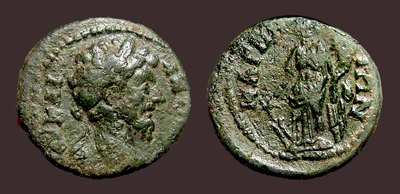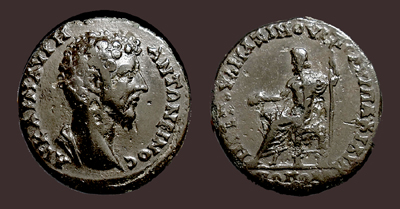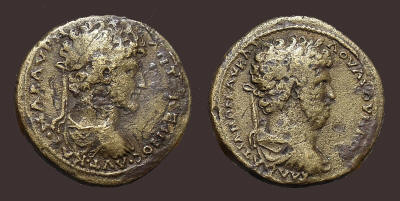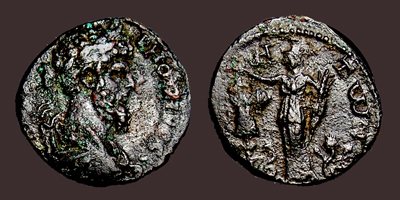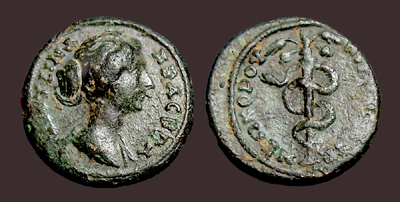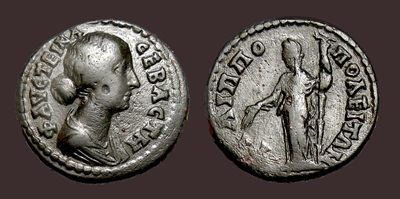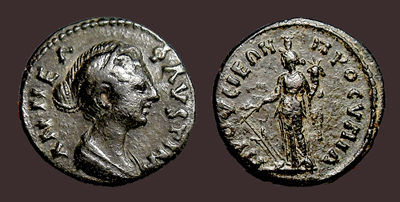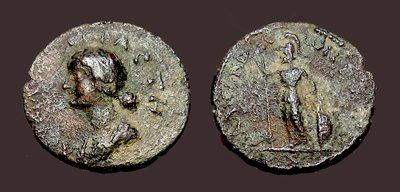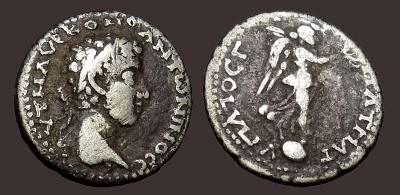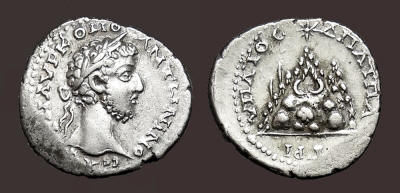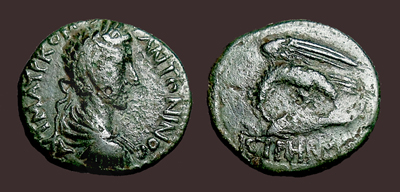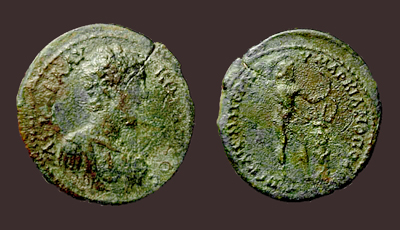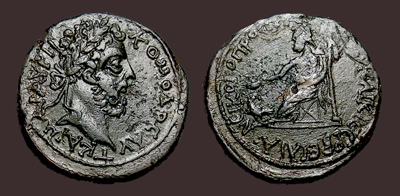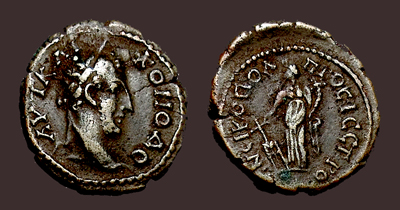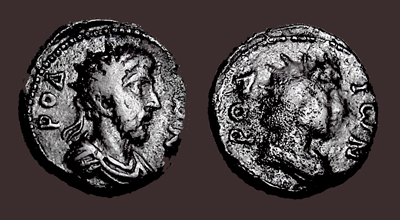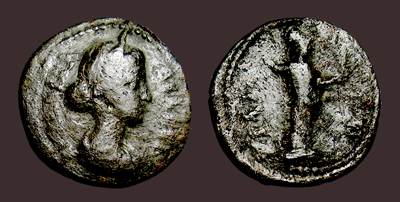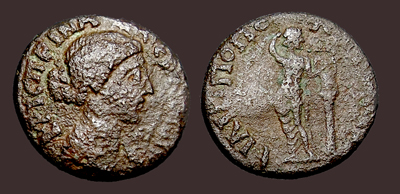|
Akropolis Ancient Coins ANCIENT GREEK IMPERIAL - ANCIENT ROMAN PROVINCIAL COINS
1. Augustus and Divus Julius Caesar. ∆ 21. Obv: ΘΕΟC; Bare head of Julius Caesar, r. Rev: CΕΒΑCΤΟΥ (ΘΕ); bare head of Augustus, r. BMC Thessalonica 61, but: RPC 5421, "Uncertain" mint...............(Image) SOLD 1a. PHRYGIA, Laodicea ad Lycum. Pseudo-autonomous issue. Time of Tiberius. 14-37 AD. ∆ 16mm; 2.82 gm; 6h. Obv: Laureate head of Apollo right; lyre to lower right; ΛΑΟΔΙ(ΚE)ΩΝ to left and below. Rev: Serpent-entwined altar, surmounted by headdress of Isis. ΠYΘHΣ to left, ΠYΘOY to right. Pythes, son of Pythes, magistrate. RPC 2903; SNG Copenhagen 510 (temp. Augustus); SNG von Aulock 3806 (same); BMC 61 (same). VF. Excellent brown/black patina. Earthen deposits have been mostly removed from the obverse and reverse, but still remain on the edge. Very few light scratches on the obverse.........................................................(Image) $85 2. "Quinctilius Varus, give me back my legions." cried Caesar Augustus!
SELEUCIS and PIERIA, Antioch. Pseudo-autonomous issue. temp. Augustus, 27 BC- 14
AD. ∆ Trichalkon (20x17mm, 7.82 g, 2h). Struck under P. Quinctillius Varus,
Governor of Syria. Dated Year 25 (ΕΚ) (7/6 BC). 3. Antoninus Pius. ALEXANDRIA HARBOR SCENE. Alexandria, Egypt; dated 154/155 AD (year 18). ∆ drachm (32 MM). Obv: Bust of Antoninus Pius, l. Rev: Isis Euploea standing facing, head left, holding grain ears upward in right hand, reversed rudder in her left. To left, prow of galley with billowing sail, moving right, behind her. Another similar galley to right, moving left (neither visible in Emmett specimen). Euthenia reclining right and river-god Nilus holding rudder, reclining left at Isis' feet. Date ďL Ė IHĒ across upper fields. Reverse
like Emmett 1589; Milne 2290 variant; BMC 1173 variant; Dattari 2899, but
obverse bust left. Traces of drapery on obverse bust, so Dattari-Savio 8776.
Probably from the same obverse die. As such, the second known variety.
Remarkably interesting motif which is far sharper and complete in condition, and
all details compared to Emmett and BMC! Excellent
patina................................................................(Video)(Image)
$3975 4. Marcus Aurelius. 161-180 AD. Pessinus, Galatia. ∆ 25. Obv: ΑΥΤ Κ Μ ΑΥΡΗΛΙΟC ΑΝΤΩΝΕΙΝΟC.
Obv: Lureate-headed bust of Marcus Aurelius wearing cuirass and paludamentum, r.
Rev: CΕΒ ΤΟΛΙCΤΟ ΠΕCCΙΝΟΥ. Nude Hermes standing, facing, head, l., holding purse and caduceus. 5. Commodus. 177-192 A.D. Pautalia, Thrace; ∆ 18. Obv: His laur. hd. r.; Rev: Highly unusual Cista, lid open, with serpent emerging; lagobolon to r. Near EF, but some legends off flan or weak. Green patina. RPC IV___ Apparently unlisted and, thus, quite rare. This coin has been submitted for inclusion into RPC IV.......................................................................(Image) $85 6. Commodus. 177-192 AD. Marcianopolis,
Moesia Inferior, ∆ 21; 5.9 gm; 6h. Obv: ΑΥ Κ Λ ΑΥΡ ΚΟΜΟΔΟC; His laureate, draped
and cuirassed bust right. Rev: ΜΑΡΚΙΑΝΟΠΟΛΙΕΤΩΝ; Tyche/Demeter/ Euposia standing facing,
head left, wearing kalathos, holding rudder and cornucopia, with infant Ploutos
- Pluto
seated in the curve of the cornucopia, raising his left hand toward an ear of
corn hanging from the cornucopia. This coin is listed in several sources, none of which describe Plutos'
presence, such as RPC IV online (Temp) #4320. Varbanov__. References to Varbanov
709 are incorrect. That coin does not include Ploutos/Pluto. A fine depiction of
Ploutos/Pluto on the cornucopia is at the coin below (6a).........(Image)
$175 6a. Phrygia,
Laodikea/Laodicea ad Lycum. Pseudo-autonomous. 7. Septimius Severus. 193-211 AD. Hadrianopolis, Thrace; ∆ 28. Obv: His laureate and draped bust, r. Rev: To right, Pan, with goat legs, holding lagobolon and facing HERMAPHRODITOS (!!) on the left. Note that Hermaphroditos depicts both male and female attributes. The legend of this mythological figure stems apparently from a single ancient source: Ovid, in his play Metamorphosis. He was said to have been the son of the messenger god Hermes and Aphrodite, the goddess of love. He was born a male and nursed by Naiads in the caves of Mount Ida in Asia Minor. At the age of 15 he wandered through the lands of Lycia and Caria. In his travels, he came upon a beautiful pool of clear water, in which lived the Naiad Salmacis, who was gathering flowers nearby. He decided to refresh himself by bathing in the pool. Salmacis, struck by his handsomeness, slipped into the pool with him and sang to him of her love. However, the youth rejected her advances. Salmacis embraced him and tried to win him over, and prayed to the gods that they be joined together as one, forever. The gods granted her prayers and the two were joined, displaying both male and female attributes of the two; hence, the name Hermaphroditos (Hermaphrodite). The coin is in VF condition, with a dark green patina. The patina is chipped on the obverse edge, with a small, hard green deposit behind Severus' ear. This is an exceedingly rare coin; the second example of which I have seen in 40 years! It is not listed in the British Museum catalog, SNG Copenhagen, or in Jurukova's corpus on Hadrianopolis, though its obv. die is her V114. See Varbanov II (English), 3392 for a second example, incorrectly identified as Apollo, in my opinion. The referenced source as "WW" is also incorrect.......(Video)(Image) SOLD 8. Septimius Severus. 193-211 AD. Anchialos, Thrace; ∆ 29. Obv: His laur. hd., r. Rev: Demeter standing l., veiled; holding flaming torch in left arm. She faces a conical wicker basket pointed at both ends (fish trap?), around which is a coiled serpent extending toward Demeter, whose hand is raised toward the serpent, as if to touch it. There is a "Δ" (4 assaria) in the center field, with two pellets above it. This is an enigmatic mythical depiction which has not been explained. Indeed, leading authors disagree as to the nature of the conical object in the left field, with B.V. Head and AMNG (Strack) describing it as a torch, but the British Museum describing it as above. However, the sole known example of this coin available to them was far inferior to this example. The "torch" interpretation seems to be refuted by this coin, which clearly shows the serpent coiled about what Head and Strack would identify as the flame; a highly unlikely scenario. This coin may be the second known example, and the finest by far. BMC Thrace, 84. 6; AMNG (Strack) II, 1, p.234, no. 467, pl. VI, 27 (referencing the sole example in BMC)....................................................(Video)(Image) $475 9. Septimius Severus.
193-211 AD. Odessos, Thrace; ∆ 27. Obv: ΔΙVΩ CΕΥΗΡΩ
ΠΕΙΩ (Divus Severus Pius). His bare head, r.
Rev: ΟΔΗCCΕΙΤΩΝ. The Great
God of Odessos stg.facing, hd. l., holding cornucopia in left
arm and patera over altar to his right. Sear GI 2129, where-in Sear
states "Posthumous types are rarely encountered in the
Greek Imperial series, other than the issues for Divus
Augustus." 10. Septimius Severus. 193-211 AD. and Clodius Albinus 195-197 A.D., Caesar. Pautalia, Thrace; ∆ 25. Obv: ΑΛΒΕΙΝ... to l., ΚΛCCΕΥΗ. Their busts facing, Severus' laur. and Albinus' bare head. Rev: Coiled serpent between tree and altar. This remarkable coin of Septimius Severus and the doomed Clodius Albinus is very rare. Varbanov 4866 cites a single example in a Private Collection"(PC, Unpublished) R8." But the single example Varbanov pictures is THIS COIN! Thus, unique?.......(Image) SOLD 11. Septimius Severus.
193-211 AD. Nicopolis, Moesia Inferior; ∆25. Obv: (AVT Λ CEΠT)
- CEVHP ΠEP; His laur. head
r. Rev: VΠ AVP ΓAΛΛOV - (NIKOΠOΛEIT)ΩN,
in ex: ΠPOC ICT(P); Mt. Haimos as a young man sitting left on a rock, with a light gown over his shoulder and knees; his head turned to the right. His right arm is raised over his head and his left hand is resting on the rock or a tree stump. A bear at the base of the rock springs right, toward a deer fleeing right. The legend includes the Roman legate Gallus' name.
F/aVF. HrHJ (2018) 8.14.43.3, scarce (R5).
Three examples cited..............................................................................(Image)
SOLD 12. Plautilla, wife of Caracalla. Nicopolis, Moesia Inferior; ∆ 25. Her marriage to Caracalla was demanded by his father, the Roman emperor Septimius Severus, since Plautilla's father, Plautianus, was an old friend of Septimius Severus (who had appointed him as his praetorian prefect). Her father fell out of favor in 205 A.D., whereupon she was banished to the Lipari islands. She was murdered by Caracalla's order in 211 A.D. Obv: Her bust, right. Rev: Aphrodite standing nude, facing, and modestly covering herself with her hands. AMNG (Pick)___, BMC___ (a single example for Plautilla, with different reverse), SNG Copenhagen___ (NO examples for Plautilla!). A single example cited by Varbanov, #3202. Scrape on Plautilla's face and areas of obverse and reverse patina roughness. HrHJ (2018) 8.21.15.1 (same dies), scarce (R6). Overall condition: VF+, with fine, dark green patina.......................................................................(Image) SOLD 13. Another excellent bronze of Plautilla; Nicopolis, Moesia inferior; ∆ 25. Obv: Her bust, right. Rev: Athena standing facing, head right, and holding spear and shield, the latter on a small base. BMC___ (a single example for Plautilla), SNG Copenhagen___ (NO examples for Plautilla alone). Varbanov (Engl.) 3189. THIS COIN pictured! HrHJ (2018) 8.21.4.3 (same dies). Superb glossy dark green patina. The condition is about EF with slight roughness in the reverse right field....................(Video)(Image) $295 14. Geta, as caesar. 198-209 AD. Nicopolis, Moesia Inferior; ∆ 16. Obv: His bare head r. Rev: Eros standing facing, head l., holding a down-turned but flaming torch in his r. and a bow in his l. AMNG__, Varbanov__ , Hristova/Jekov 8.22.16.4 (this coin illustrated)...................... (Image) $125 15. Geta. 209-212 AD. Philippopolis, Thrace; ∆ 28. Obv: His laur., dr., and cuir. bust right. Rev: Emperor stg. facing, hd. l., sacrificing over tripod altar, and holding scepter, to right of a statue of Apollo Kendrizos on a column; victimarius holding axe to l., bringing bull to r. for sacrifice. Varbanov III, 1626. RARE (R7)!....................................................(Image) $125 16. Diadumenian. 218 AD. Nicopolis, Moesia Inferior; ∆ 27. Obv: His bare- headed, draped bust, right. Rev: Diadumenian on horseback, right, brandishing spear in his right arm; enemy beneath hooves of horse. Excellent dark green patina. VF+/EF. AMNG (Pick) 1870. HrHJ (2018) 8.25.34.1 (same dies)......................................................................(Image) $245 17. Elagabalus. 218-222 AD. Nicopolis, Moesia Inferior; ∆ 26. Obv: His radiate, draped, and cuirassed bust, right. Rev: Mt. Haimos as a young man sitting left on a rock, with a light gown over his shoulder and knees; his head turned to the right. His right arm is raised over his head and his left hand is resting on the rock or a tree stump. A bear at the base of the rock springs right, toward a deer fleeing right. The legend includes the Roman legate Rufus' name. AMNG (Pick) 1953. HrHJ (2018) 8.26.43.1 (same dies). Nice dark green patina. VF.......................................(Image) $185
18.
Severus Alexander. 222-235 AD. ∆ 30, and of MEDALLIC style! Kotiaeon/Cotiaeum,
Phrygia. Obv: M
AVP CΕVΗ
ΑΛΕΧΑΝΔΡΟ-C
AVΓ.
His bust left with imperial mantle, holding scepter in l. hand,
which slants over his left shoulder, and raising right hand (in greeting?).
Rev: ΕΠΙ
Π
ΑΙΛ
ΕΡΜΑΦΙΛΟΥ
APXONTOC;
"A" in upper center field; in
exergue: KOTIAEΩ(N).
Asklepios standing facing, head toward Hygieia.
A small Telesphoros between them; the "N" from the exergue over his
head. SNG Tubingen 4111. Tubingen states "Unpublizierte
Variante?" - Unpublished Variant? This, then, is probably the
second know example of this coin! BMC__; von Aulock__; Mionnet__; SNG
Cop__. aEF; at least three grades superior to the Tubingen example
(image available upon request)!
Finest known
specimen!........................................................................(Video)(Image)
$3950 20. Philip I and Otacilia Severa. 244-249 AD. Tomis, Moesia Inferior. ∆ 27. Obv: Their busts facing. Rev: Homonia stg. facing, head l, wearing kalathos and holding patera and cornucopia. Altar before her? Varbanov I (E), 5765, rated R4 for rarity. Great surfaces and patina.(Video)(Image) $185 21. Philip II, as caesar. 244-247 AD. Tomis, Moesia Inferior; ∆ 26. Obv: His bare headed, draped and cuirassed bust face-to-face with Sarapis. Rev: Tyche of the city standing facing, holding scepter and cornucopia, with her left foot on the shoulder, in a dominant manner, of Pontos, (the Black Sea). In short, in command of the Black Sea and its trade routes. This is our speculation, since no numismatic publication addresses the meaning of the placement of the Tyche of Tomis's left foot upon Pontos' shoulder. Pontos is shown from the waist up, bearded, wearing a crab shell with attached crab claws on his head. Pontos is described in Greek mythology as the ancient personification of the sea (Tomis is on the Black Sea). Pontos was the father of Nereus, also known as "the old man of the sea." Nereus was the son of Pontos and Gaea and father of the water nymphs Nereids and Nerites. One of the Nereids was Thetis, who was the mother of the famous hero Achilles. He was considered to be a gentle and trustworthy god, who never lied. Gradually, Nereus was replaced by another sea god, Triton. It is noted that Varbanov describes the figure as the River God Hebros in contradiction to AMNG. Wonderful dark brown patina. AMNG Vol I/II, 3613. Varbanov I, 5820, but which states "as 5818" incorrectly, since 5818 has a "Δ" in the reverse field, absent in this example.........................................................................(Video)(Image) SOLD 22. Antoninus Pius. 138-161 AD. Creteia-Flaviopolis, Bithynia and Pontus. ∆ 17; 3.7 gm. Obv: AYT KAICAP ANTΩNIN(OC), His laureate and draped bust, r. Rev: (KPHT)IEΩΝ ΦΛ(ΑΟ)ΥΙΟ. Nude Pan seated on a rock, facing, head l., holding syrinx and grasping reed representing the transformed nymph Syrinx. Pan was the god of the wild, hunting and companion of the nymphs. He was depicted as being half human, while having the legs and horns of a goat, as can be seen on this coin. Pan's body is covered with hair/fur, which is apparently unique to this representation of Pan on an ancient coin! VF/VF, with a splendid dark green patina. Unpublished and unique, as of this writing, though this coin will be published in RPC IV. It is currently included in the online publication as no. 11098 (Temporary)..........(Video)(Image) $2250 23. Severus Alexander. 222-235 AD. Tarsos, Cilicia. ∆38 mm, 23.51 gm. Obv: ANT ...AYP CEV ΑΛΕΞΑΝΔΡΟC CEB; Laureate, draped and cuirassed bust, right. Π-Π on either side. Rev: ΑΛΕΞ CΕ ΑΔ.....ΠΑΤΡOΩC(center of field) TAPCEΩ(Ν) in ex. Perseus standing right, holding harpa and small statue of Apollo Lykeios. Before him, the fisherman Dictys, who saved him and raised him from boyhood, standing left, holding fish and basket on either end of a long rod. Like SNG von Aulock 6046, for Gordian III. Roughly similar to SNG France , Cilicia, 1574, and cross-referenced to Waddington "Inventaire Sommaire" 1347 (same coin). BMC__; SNG Cop__. Possibly unpublished. Quite worn. Dark red-brown patina........(Image) $275 24. Severus Alexander. 222-235 AD. Perinthus, Thrace. ∆ medallion; 36 mm, 17.74 gm. Obv: Radiate, draped and cuirassed bust right, seen from behind. Rev: ΠΕΡΙΝΘΙWΝ ΔΙΣ ΝΕΩΚΟΡWΝ, Triptolemos in chariot right, drawn by two winged serpents. SchŲnert 737 (B/i); SNG Cop.__.Near black patina. Some light smoothing.......................................................(Image) $475 25. Gordian III. 238-244 AD. Tarsos, Cilicia. ∆ 36; 19.78 gm. Obv: AYT KAI M ANTONIOC (sic) ΓΟ(PΔΙΑΝΟC CΕΒ). Π - Π to right and left. Laureate, draped and cuirassed bust, right. Rev: TAPCOY MHTPOΠΟΛΕΩC AMK ΓB; Herakles in the garden of the Hesperides, facing, head left, holding club in his right hand and apple(s) in his left hand with the skin of the Nemean lion draped over his left arm. in the trεe to left, the dead guardian dragon Ladon, which Herakles had to kill to get the golden apples. Ziegler 772, double die match. SNG France 1669. AMK = The first, largest and most beautiful (city in Cilicia). Brown-black patina.............................(Image) $225
26.
Trajan Decius. 249-251 AD. Tarsos, Cilicia. ∆ 32. 14.51 gm. Obv: Radiate, draped
and cuirassed bust, right, as seen from behind. Π - Π to right and left. Rev:
Herakles holding club in right hand, lion's skin draped over left arm and left
hand holding the infant Telephos, who reaches down to a Doe (hind), which looks
up at him; tree of the
garden of Hesperides in the background? AMK in the exergue. Rough condition. 27. Augustus. 27 BC-14 AD. ∆ "Sestertius." (36 mm; 22.66 gm.) Uncertain mint in Asia minor. Struck circa 25 BC. Obv: Bare head right. Rev: Large CA within laurel wreath framed by double-pelleted border. RPC 2233; Howgego, Coinage, Class 2a; RIC I 501 (Pergamum).................(Image) $375
28.
AELIUS, Caesar. 137 AD. Philippopolis, Thrace. (∆
33; 21.34 gm) 29. Domitian. 81-96 AD. Philippopolis, Thrace. ∆ 33mm (21.55 gm). Both Latin and Greek legends. Obv: IMP CAES DOMIT AVG GERM COS XIIII CENS P P P, laureate head right. Rev: ΦIΛIΠΠO ΠOLEITΩN, female standing left, holding patera and hem of skirt; at her feet, Rivergod Hebrus reclining right. RPC II 351 (var); BMC Thrace__; SNG Copenhagen__; Varbanov III, 622...........................................................................(Image) SOLD 30. Julia Domna. Augusta, 193-217 AD. Antioch, Pisidia. ∆, large 34mm (25.89 gm, 6h). Obv: Draped bust right. Rev: MÍn standing facing, head right, crescent on shoulders, left foot on bucranium, leaning on low cippus to right, and holding scepter in right hand and Nike in left hand. To left, cock standing left, head right. S - R across fields. Krzyzanowska XXI/48; SNG France 1121 (same obverse die). VF. Glossy black patina on obverse, with excellent portrait. Scarce.......................................................(Image) $185 31. Julia Domna, Augusta. Antioch, Pisidia. (∆ 33. 24.26 gm). Per Curtis Clay, the coin will date to between Geta's promotion to Augustus late in 209 and his assassination by Caracalla in Dec. 211. Obv: Her draped bust, right. Rev: CONCORD AVGUSTOR COL ANTI OCH, Caracalla and Geta as joint Augusti, clasping hands; S - R across field. Unlisted in major references, nor on-line sources. Silver plated in antiquity? Silver evident on her forehead, hair, and letters of her name. A unique special presentation issue? Dark black patina........................................(Image) $275
32. Caracalla. 98-217 AD. Philippopolis,
Thrace. ∆ Medallion (35mm, 25.54 gm, 8h). Struck 215 AD. Obv:
AVT K M AVΡ CEΥH ANTΩNEINOC,
radiate,
draped, and cuirassed bust right. Rev: K(OINO)N ΘΡAKΩN
AΛEΞANΔΡIA/ EN ΦIΛIΠΠOΠOΛΙ,
table seen in perspective to right,
surmounted by prize urn containing two palms and
inscribed ΠΥΘΙΑ (worn off here); below, five balloting balls,
palm
branch and amphora. Moushmov, Philippopolis__ ; Varbanov 1485, rarity 6. VF, brown
surfaces. 33. Another similar medallion, except (37 mm, 24.49 gm); Rev:KOINON ΘΡAKΩN AΛEΞAN EN /ΦIΛIΠΠO. Prize urn containing five balls; (Palm branch, not visible here) and amphora below table. BMC 39; Varbanov 1420, rarity 6. Dark brown toning...................................................(Image) $95 34. Caracalla and Geta. 211-212 AD. Stratonicaea, Caria. ∆ 34mm (23.21 gm)Obv: Laureate, draped, and cuirassed bust of Caracalla right and obliterated laureate, draped, and cuirassed bust of Geta left, vis-ŗ-vis; c/ms: helmeted male head, right in circular incuse; [ΘEOU] within rectangular incuse below. Rev: Hekate standing left, holding patera and torch; altar at her feet. For coin type: BMC Caria 69; SNG von Aulock 2687; for c/ms: Howgego 188 and 536. The intentional erasure of Geta's portrait and name followed the dictates of that emperor's damnatio memoriae following his murder at his brother's hands in 212 AD.............(Image) SOLD 35. Maximinus I, with Maximus, Caesar. 235-238 AD. Tarsus/Tarsos, Cilicia. ∆ 37mm (27.07 gm). Obv: Radiate, draped, and cuirassed bust of Maximinus right, seen from behind; Π - Π on either side. Rev: Radiate and draped bust of Maximinus right vis ŗ vis laur., draped, and cuir. bust of Maximus left. SNG von Aulock__; BMC__; SNG Cop__. Alram / MIR, plate 32, Nr. 58 illustrates a specimen from the same obv. die. SNG Levante 1105 (var. - obv. legend). Rare...............................................................(Image) $225
36.
Gordian III. 238-244 AD. Antioch, Pisida. ∆36 x 31 mm; 21.22 gm. 37. Gordian III. 238-244 AD. Antioch, Pisidia. ∆ 31mm (22.07 gm, 6h). Obv: Laureate, draped, and cuirassed bust right, seen from behind. Rev: She-wolf standing right, head lowered left, suckling the twins Romulus and Remus; fig tree to left. Krzyźanowska dies IX/37; SNG France 1225-7 (same dies).SNG von Aulock 4953. Near EF, attractive glossy black patina. Interesting portraiture. Like CNG Coin Shop #863262 (same obverse dies and possibly same reverse dies).This coin much better in both wear and patina.............................................................................................(Image) SOLD 38. Philip I. 244-249 AD. Seleuceia ad Calycadnum, Cilicia. ∆ 36mm (22.93 gm, 6h) Radiate, draped and cuirassed bust r, Rv. Confronted busts of Tyche and Apollo. SNG von Aulock 5846-5850 (var)..................(Image) $185 39. Valerian II. Caesar, 256-258 AD. Aspendos, Pamphylia. ∆ 32 (16.91 gm). Obv: ΠOΥ ΛIK KOΡ OΥAΛEΡIANON KAIC CE, his bare and draped bust, right, above an eagle with wings spread. Mark of value "A" in right field not visible. Rev: ACΠEN-ΔIΩN, Hephaistos wearing conical cap seated right, holding hammer in r. hand, and shield of Achilles (?) in left hand. Flaming forge below and to the right. BMC__; SNG Cop__; von Aulock__; SNG France__; SNG PFPS__; Leopold__; Isegrim__. Cf. SNG France 207 (for rev. type [Valerian I]). Apparently unpublished.........................(Image) $1250 40. Octavian. 31-30 BC. SYRIA, Coele-Syria, Chalkis ad Libanon. ∆ 21mm, 6.64 gm, 12h. Zenodorus, tetrarch and archereus. Obv: Bare head of Octavian right. Rev: Bare head of Zenodorus left . RPC I 4774; cf. SNG Copenhagen 417...............................................................................(Image) $35 41. Another. Date in right field of obverse. 19mm, 5.42 gm, 11h..(Image) $35 42. Mark Antony and Octavian. Thessalonica, E=Year 5=37 BC. AE (30mm, 17.15 gm. 1h). Obv: Draped bust of Eleutheria right; E (date) to left; [ΘΕ]ΣAΛONIKEΩN EΛEYΘEPIAΣ around. Rev: Nike advancing left, holding wreath and palm frond; M ANT AYT ΓKAI AVT around. RPC 1551. Sear, Imperators 672; SNG Cop 374. Glossy very dark green surfaces. VF. Flan weight adjustment scrapes (?) on the reverse. The bust of Libertas on the obverse "refers to the grant of freedom by the Triumvirs to Thessalonica in 42 BC after the battle of Philippi, the victory which is celebrated on the reverse" (RPC, p. 297)....................................................................(Image) $225 43. Augustus, with Caius Caesar. Thessalonica. 27 BC-14 AD. ∆ (23mm, 9.73 gm, 3h). Obv: Laureate head of Augustus right. Rev: Bare head of Caius Caesar right. RPC 1564; Touratsoglou, Thessaloniki, Em. X, 159 (V46/R142); Varbanov 4156; BMC 73; Lind. 1188......................(Image) SOLD 44. Augustus. 27 BC- 14 AD, Sardis, Lydia. ∆ (19 mm, 4.99 gm, 11h). Obv: (ΣΕΒΑΣΤ)ΟΥ, Bare head, right. Rev: ΔΙΟΔΟΡΟΣ ΕΡΜΟΥΦΙΛΟΥ ΣΑΡΔΙΑΝΩΝ, Zeus standing left, holding eagle and staff. RPC 2986. Rare..............................................................................................(Image) SOLD 45. Augustus. 27 BC-AD 14. MACEDON, Uncertain (Pella or Dium?). ∆ (24mm 9.52 gM, 11h).Obv: (IMP CAESARI AVGVSTO) IX COS, Laureat head of Augustus, right, Rev:M FICTORI M SEPTUM II VIR QVIN, M. Fictorius and M. Septimius, quinquennial duoviri. Name and titles of duoviri within laurel wreath. RPC 1528; Varbanov 3709 (Pella). Rare.................(Image) $75 46. Augustus. 27 BC-14 AD. AR Cistophoric Tetradrachm (27mm, 11.13 gm, 12h). Pergamum mint. Struck circa 19-18 BC. Obv: IMP IX T(R POT V), Bare head right. Rev: S P R/SIGNIS/RECEPTIS across field within triumphal arch; legionary aquilae before spandrels; triumphal qudriga above; IMP IX TR POT V across entablature. RIC I 508; RPC I 2218; BMCRE 703 (Ephesus);RSC 298............................................................(Video)(Image) $975 47. KINGS of THRACE. Rhoemetalces I & Pythodoris, with Augustus. Circa 11 BC-12 AD. ∆ (25mm, 10.43 gm, 5h). Obv: Jugate heads of Rhoemetalces and his queen Pythodoris right. Some drapery on Pythodoris. Rev: Bare head of Augustus right. Youroukova 204; RPC I 1711......................................................................................(Video)(Image) $265 48. KINGS of THRACE. Rhoemetalces I, with Augustus. Circa 11 BC-12 AD. ∆ (19mm, 4.54 g, 6h). Diademed head of Rhoemetalces right / Bare head of Augustus right. RPC 1718; Youroukova 194-200.......................(Image) $145 49. Another.....................................................................................(Image) $35 50. Another.....................................................................................(Image) $145 51. Another.....................................................................................(Image) $130 52. Tiberius, Augustus. 14-37 AD. Apollonia Salbace Caria. ∆ (18mm, 6.72 gm, 7h). Obv: ΣΕΒΑΣΤΟΣ, Bare head r. Rev. ΚΑΛΛΙΠΠΟΣ ΑΡΤΕΜΙΔΩΡΟΥ ΑΠΟΛΛΩΝΙΑΤΩΝ Apollo standing l., holding raven and laurel branch. SNG Copenhagen 145. RPC 2864.........................................................(Image) SOLD 53. KINGS of THRACE. Rhoemetalces II, with Tiberius. Circa 19-36 AD. ∆ (22mm, 9.61 gm, 5h). Obv: Jugate heads of Rhoemetalces II, diademed, and his queen right. Rev: Bare head of Tiberius right. RPC I 1721; Youroukova 201-203.....................................................................(Image) SOLD 54. Tiberius, with Julia Augusta (Livia). 14-37 AD. LESBOS, Mytilene. ∆ (20mm, 5.14 gm, 11h). Struck circa AD 35. Obv: TI ΘEOC CEBACTOC, MYTI in field. Laureate head of Tiberius left. Rev: IOY ΘEA CEBACTH, MYTI in field. Draped bust of Livia right. RPC 2346, (This coin); Lind. 430 (This coin). Near VF, UNIQUE. No other examples known to RPC!...(Image) SOLD 55. Germanicus, with Agrippina Senior. Died 19 and 33 AD, respectively. PHRYGIA, Aezanis. ∆ (19mm, 3.75 gm, 12h). Commemorative issue. Straton Medeus, magistrate. Struck under Gaius (Caligula), 37-41 AD. Obv: Laureate head of Germanicus right. Rev: Draped bust of Agrippina right. RPC I 3077; SNG Copenhagen 75. Rare.......................................(Image) $75 56. Gaius Caligula. 37-41 AD. CORINTHIA, Corinth. ∆ (21mm, 6.06 gm, 10h). P. Vipsanius Agrippa, duovir. Obv: C CAESAR AVGVS, bare head right. Rev: P VIPSANIO AGRIPPA II VIR, Pegasus flying right. RPC I 1172; Amandry XVII21 b/Ij; SNG Cop. 255; BCD Corinth 402.............(Image) SOLD 57. Claudius. 41-54 AD. MACEDON. Cassandrea. ∆ (23mm, 9.83 gm, 6h). Obv: TI CLA CAES AVG GERM P M TR POT, laureate head left. Rev: COL IVL AVG CASSANDR, horned head of Ammon right. c/m: AVG in rectangular incuse. RPC I 1515. For c/m: Howgego 576...............(Image) $45 58. Claudius. 41-54 AD. MACEDON, Philippi. ∆ (26mm, 10.39 gm, 10h). Obv: Bare head left. Rev: Statuary group with Augustus being crowned by Divus Julius Caesar on base inscribed D]VVS / AVG in two lines. RPC I 1653; SNG ANS 684; SNG Copenhagen 3074...............................(Image) $125 59. Agrippina Jr. Reign of Claudius I, her husband. Calchedon, Thrace. ∆ 24 mm, 5.70 gm, 10h). Obv: (ΑΓΡΙΠΠΙΝΗΣΣΕΒΑΣΤΗΣ) Bust of Agrippina II, left. Countermark PKA (cf. Howgego 611: 1). Rev: (ΚΑΛΧΑΔΟΝΙΩΝ), Bust of Artemis right, with bow. RPC I 1788. Exceedingly rare. Only one example known to the authors of RPC.........................................................(Image) $85 60. Agrippina Jr. 50-54 AD. LYDIA, Philadelphia. Magistrate Ti. Neikanor. ∆ (15 mm, 3.72 gm, 9h). Obv: Draped bust rirght. Rev: Cornucopia. RPC 3042 (Rare. 8 examples known}. Very dark green patina...........(Image) $175
62. Another. (15mm, 1.69 gm, 1h).....................................(Video)(Image) $325 63. Nero, 54-68 AD. Phrygia, Prymnessos. Magistrate Ti Julius Proklus. ∆ (21 mm, 4.39 gm, 1h). Obv:ΝΕΡΟΝΑ ΚΑΙΣΑΡΑ ΠΡΥΜΝΗΣΣΕΙΣ, Laureate head, right. Rev:TI ΙΟΥΛΙΟΥ ΠΡΟΚΛΟΥ, Dikaiosyne holding scales and two ears of corn. RPC 3207. Rare, 9 examples known.....................(Image) $125 64. Nero. 54-68 AD. Lydia. Sardes. ∆ (17 mm., 2,98 gm,6h). Obv: NEPΩN KAICAP. Laureate head, right. Rev: EΠI TI MNACEOY CAPΔIANΩN. Laureate head of Hercules right, with lion skin tied around neck. RPC 3009. Rare, 8 examples known..............................................................(Image) $165 65. Nero. 54-68 AD. THESSALY, Koinon of Thessaly. ∆ (24 mm, 8.35 gm, 7h). Obv: Laureate head right. Rev: Apollo Lykeios standing right, plucking lyre. RPC I 1439; Burrer 14 (A3/R11); SGI 548...........................(Image) $85 66. Poppaea. Augusta, 65-65 AD. ∆ (24mm, 9.48 gm, 1h). Perinthus, Thrace. Obv: Draped bust right, wearing stephane. Rev: Isis headdress; Π E across field; all within laurel wreath. RPC 1756; SchŲnert-Geiss, Perinthos, 277; Varbanov 27. Dark black patina. Numerous scratches in obverse fields, otherwise, near EF..............................................(Image) $145 67. Vespasian. 69-79 AD. CILICIA, Soli-Pompeiopolis. ∆ (23mm, 11.58 gm, 7h). Obv: Laureate head right. Rev: Turreted and veiled bust of Tyche right. SNG Levante 888; RPC ΙΙ, 1722, two examples cited. Very rare.(Image) $125 68. Domitian. 81-96 AD. Antioch ad Maeandrum, Caria. ∆ (19 mm, 5.34 gm, 7h). Obv: ΔOMITIANOC KAICAP, laureate head, right. Rev: ΕΠΙ ΜΕΛΗ[ΘΕΝΤΟC ΤΙ] ΚΛ ΑΓΛΑΟΥ ΦΡΟΥΓΙ ΑΝΤΙΟΧΕΙΑ, turreted city-goddess (Antiochia) seated l., holding patera RPC II, 1219, BMC 29, Sng Cop 48. Nine examples cited. Rare thus. A good example for wear, but numerous cleaning scratches.....................................................................(Image) $125 69. Domitian. 81-96 AD. CILICIA, Flaviopolis. ∆ (14mm 2.20 gm, 12h). Obv: Laureate head of Domitian right. Rev: ETOYC ZI ΦΛAΥIOΠOΛEITWN, bust of Dionysos right, thyrsos over shoulder. RPC II 1761; BΜC Cilicia__; SNG Levante 1533; .Lindgren1495, THIS COIN....................................(Image) $185
70.
Trajan. 96-117 AD. Amastris Paphlagonia. ∆ (22 mm, 4.76
gm, 6h. Obv: 71. Trajan. 96-117 AD. Attaos, Mysia. ∆ (17 mm, 3.23 gm, 11h). Obv: AYT KAI CAP CEB, Laur. head of Trajan, right. Rev: ATTAITΩΝ Draped Bust of Senate, right. BMC 3-4, Augustus, reattributed to Trajan and Attaos from Attaea; RPC 1755. Only 17 other specimens known...................(Image) $65 72. Trajan. 98-117 AD. MYSIA. Miletopolis. ∆ (22 mm, 5.71 gm, 6h). Obv: Laureate head right. Rev: Helmeted bust of Athena right, wearing aegis. SNG France 1307; SNG von Aulock__; RPC 1640...........(Video)(Image) $145 73. Trajan. 98-117 AD. Seleucia Pieria, Syria. ∆ (25 mm, 8.20 gm, 12h). Obv: AVTOKPA KAIC NЄP TPAIANOC APICT CЄB ΓЄPM ΔAK, laureate head right. Rev: CЄΛЄVKЄWN ΠЄIЄPIAC / SЄVC / KAICIOC, baetyl (sacred stone) of Zeus Kasios within shire surmounted by eagle; Γ to lower right. RPC 3769.......................................................................................(Image) SOLD 74. Hadrian. 117-138 AD. CAPPADOCIA, Caesarea. AR Drachm (19 mm, 3.05 gm, 6h). Dated COS. 3 (128-138 AD). Obv: Laureate bust right, slight drapery on far shoulder. Rev: ΥΠATOC Γ ΠATHΡ ΠATΡ, Mount Argaeus, three stars above. BMC 125. Sydenham, Caesarea 271..............(Image) $75 75. Antoninus Pius. 138-161 AD. CAPPADOCIA, Caesarea. AR Didrachm (23 mm, 7.25 gm, 12h). Struck 139 AD. Obv: Laureate head right. Rev: ΥΠAT B ΠAT ΠATΡ, Helios, holding globe and scepter, standing atop Mt. Argaeus; star in exergue. Sydenham 301c (var), (reverse legend); Metcalf 124b. Attractive portrait...................................................(Video)(Image) $225
76. MOESIA INFERIOR. Callatis/Kallatis.
Pseudo-autonomous. Time of Antoninus Pius to Marcus Aurelius (138-180). ∆ (15mm,
2.44 gm, 12h). Obv: Helmeted and draped bust of Athena right, wearing aegis. 77. Antoninus Pius. 138-161 AD. SYRIA, Seleucis and Pieria. Laodicea ad Mare. ∆ (25mm, 9.70 gm, 12h). Dated 138 AD. Obv: Laureate head right; c/m: laureate and bearded head right within oval incuse. ΙΟΥΛΙΕWN TWN K-AI ΛΑΟΔΙΚΕWΝ, Turreted and draped bust of Tyche left; ΘE before, HΠP (date) behind. The turreted headdress consisting of a gateway, turrets, walls, and a lighthouse. Bunch of grapes as an earring. RPC 4, 9109 (temporary); SNG Copenhagen 350; Hunterian 3200; for c/m: Bearded head right; Howgego 113...........................................................(Video)(Image) $145 78. Antoninus Pius. 138-161 AD. BITHYNIA, Nicomedia. ∆ (18mm, 3.38 gm, 6h). Obv: ΑΝΤΩΝ ΚΑΙСΑΡ СƐΒ, Draped bust right. Rev: DHMHT NEIKO, Demeter standing left, holding grain ears and long torch. RPC 4, 5588 (temporary); Waddington, RG 50; BMC 12-13; SNG von Aulock 744. EF, Excellent Antonine portrait. Magnificent dark green patina.......(Image) $135 79. Antoninus Pius. 138-161 AD. MOESIA INFERIOR, Nicopolis ad Istrum. ∆ (21mm 4.94 gm, 7h). Obv: ΑVΤ ΑΙ ΑΔΡΙΑ ΑΝΤΩΝΕΙΝΟС, Bare head right. Rev: ΝΕΙΚΟΠΟΛITΩΝ, Apollo Sauroktonos standing right, left hand on tree stump and holding arrow in right hand, preparing to stab lizard on tree to right. Not in RPC: RPC 4, 4328 (temporary) (var.- reverse legend); AMNG I__; SNG Copenhagen__; Varbanov I (E), 2116, "Unpublished" (Private collection); Rarity 7. HrHJ (2018) 8.6.7.3. VF, brown patina..(Image) SOLD 80. Antoninus Pius. 138-161 AD. THRACE, Philippopolis. ∆ (18mm, 3.71 gm, 7h). Obv: ΑΥΤ ΑΙ ΑΔΡΙ ΑΝΤΩΝΕΙΝ, Laureate head right. Rev: ΦΙΛΙΠΠΟΠΟΛΕΙΤΩΝ, Homonoia standing, l., holding patera and cornucopia facing, head left, RPC 4, 7452 (temporary); SNG Copenhagen__; Mouchmov, Philippopolis 84; Varbanov 776-7 var. (obv. legend); BMC __. VF+. Glossy black patina...............................................................(Image) $125 81. Marcus Aurelius. 161-180 AD. CAPPADOCIA, Caesarea. AR Didrachm (20mm, 6.81 gm, 11h). Dated COS. 3 (161-165 AD). Obv: AVTOKP ANTWNEINOC CEB, laureate head right, with a seemingly uplifted gaze. Rev: YPATOC Γ, Mount Argaeus, with standing nude figure above summit, holding spear and globe. At the base, hound chasing hare on center right of base; tree before left boulder at base. Sydenham, Caesarea 326(var. hound chasing hare) Metcalf, Caesarea 130b.............................(Image) $225
82. Marcus Aurelius. 161-180 AD. CAPPADOCIA,
Caesarea. AR Didrachm (20mm, 6.82 gm, 5h). Dated COS. 3 (161-165 AD). Obv:
AVTOKP ANTWNEINOC CEB, Bare head right. Rev: ΥΠATOC
Γ, Mount Argaeus surmounted by a statue of Helios,
holding globe and scepter. At the base, animal
to left, tree on right. Metcalf, Caesarea 129a; Sydenham, Caesarea 321; SNG von
Aulock 6434. Good VF, attractively toned, with some surface
luster................................................................................................(Image)
$225 83. Marcus Aurelius. 161-180 AD. CYRENAICA, Cyrene. ∆ (30mm, 21.47 gm, 12h). Obv: ΑΥΤΟΚΡ ΚΑΙС Μ ΑΥΡΗΛ ΑΝΤWΝEΙΝΟС СEΒ, Laureate bust of Marcus wearing cuirass and paludamentum, right. Rev: ΔΗΜΑΡΧΙΚ E(Ξ)ΟΥС ΚϚ, Head of Zeus-Ammon right. Cf. MŁller 450 (Cyrene); cf. Sydenham, Caesarea 344: RPC 4, 8006 (temporary).................(Image) $145 84. Marcus Aurelius. 161-180 AD. Magnesia ad Maeandrum, Ionia. ∆ (23mm, 7.94 gm, 6h). Obv: laureate bust right, wearing cuirass and paludamentum, r. Rev: Tyche standing, l., wearing kalathos, holding rudder and cornucopia. RPC 4, 3603............................................(Image) $35 85. Marcus Aurelius. 161-180 AD. Philippopolis, Thrace. ∆ (30mm, 17.65 gm, 12h). Obv: ΑV ΚΑΙ Μ ΑVΡΗ ΑΝΤΩΝΕΙΝΟС, bare head of Marcus Aurelius, r. Rev: ΗΓΕ ΤΟVΛ ΜΑΖΙΜΟV ΑΠΟΔ VΠΑ ΦΙΛΙΠ, in ex, ΠΟΠΟΛΙ, Zeus seated, l., holding patera and long scepter. RPC 7453. aEF, splendid glossy dark green/brown/black patina. A magnificent coin.....................................................................................(Video)(Image) $295 86. Marcus Aurelius and Lucius Verus, co-emperors. 161-169 AD. Kallatis, Moesia Inferior. ∆ (24mm, 8.17 gm, 7h). Obv: ΑV ΚΑΙ ΜΑΡ ΑV ΑΝΤΩΝEΙΝOС, laureate-headed bust of Marcus Aurelius wearing cuirass and paludamentum, r. Rev: ΑV ΚΑΙ ΛΟV ΑV ΟVΗΡΟС ΚΑΛΛΑΤΙΑΝΩΝ. laureate-headed bust of Lucius Verus wearing cuirass and paludamentum, r. RPC 4, 3517 (temporary). This example is far better than the example illustrated in RPC. Very rare. Obvious work by Greek artists depicting charming portraits..........................................................................(Image) $145 87. Lucius Verus (with Marcus Aurelius as co-emperor) 161-169 AD. Side, Pamphylia. ∆ (21mm, 6.51 gm, 12h). Obv: Laureate-headed bust of Lucius Verus wearing cuirass and paludamentum. Rev: Athena standing, facing, head, r., crowning trophy, holding thunderbolt; at feet of trophy, coiling serpent. BMC__; SNG Cop__, von Aulock__; RPC 4, 10883(Temporary). Extremely Rare. RPC shows only one example...........................(Image) $95 88. Faustina II (Augusta). Struck by Antoninus Pius or Marcus Aurelius. Nicomedia Bithynia. ∆ (20mm, 5.10 gm, 1h). Obv:ΦΑVСΤΕΙΝΑ ΝΕΑ СΕΒΑ, draped bust of Faustina II, r. Rev: ΝΕΩΚΟΡOY ΝΙΚΟΜΗΔ, lighted torch entwined by serpent, surmounted by two poppies and decorated with two ears of corn. RPC 4, 6092,(temporary); Rec Gen. 107, pl. xci 24; ex Lindgren 166, this coin. Very rare...............................................(Image) SOLD 89. Faustina II (Augusta). Philippopolis, Thrace. ∆ (24mm, 10.03 gm, 1h). Obv: ΦΑVСΤEΙΝΑ СEΒΑСΤΗ, draped bust of Faustina II, r. Rev: ΦΙΛΙΠΠΟΠΟΛΕΙΤΩΝ, veiled Demeter standing, l., (wearing kalathos), holding two ears of corn and long torch. RPC 4, 7496 (temporary), BMC Thrace pg. 162, 13; Mionnet Supp. II pg. 454, 1485; SNG Copenhagen 772. Excellent glossy black patina.........................................................(Image) $85 90. Faustina II (Augusta), struck under Antoninus Pius or Marcus Aurelius. Prusias ad Hypium, Bithynia. ∆ (22mm, 5.80 gm, 6h). Obv: ΑΝΝΕΑ ΦΑVSΤΙΝΑ(sic), draped bust of Faustina II, r. Rev: ΠΡΟVСΙΕΩΝ ΠΡΟС VΠΙΩ, Tyche standing, l., wearing kalathos, holding rudder and cornucopia. Ex Lindgren 190, THIS COIN; RPC 4, 4847 (temporary). Rec. Gen. p. 606, 23; pl. civ, b (erroneously described as Faustina Sr). Rare. Dark brown-black patina...............................................................(Image) $185 91. Lucilla. under Marcus Aurelius, and possibly Lucius Verus as co-emperors. LYCAONIA, Dalisandus. ∆ (19mm, 4.31 gm, 12h). Obv: ΛΟΥΚΙΛΛΑ CEBACTH, draped bust, left. Rev: ΔΑΛΙCΑΝΔWΝ, Athena standing, l., holding spear and shield. SNG Schweiz II, 1456(?); RPC__. Exceedingly rare, apparently the second known example......(Image) SOLD 92. Commodus. 177-192 AD. Cappadocia, Caesarea. AR Didrachm (20mm, 3.98 gm, 12h), c. 181/2. Obv: Laur. head r. Rev: Nike standing r. on globe, holding wreath and palm. Sydenham 370b (this coin)...............(Image) $125 93. Commodus. 177-192 AD. Cappadocia, Caesarea. AR Didrachm (21mm, 4.44 g, 12h). Struck AD 183-185. Obv: AYT M AYP KOMO ANTWNI, laureate head right. Rev: YΠATOC Δ ΠAT ΠA-TPI, Mt. Argaeus surmounted by star. Metcalf, Caesarea 155i; Sydenham, 372b. aEF. Lustrous..........(Image) $190 94. Commodus. 177-192 AD. MOESIA INFERIOR, Istrus. ∆ (24mm, 8.24 g, 7h). Obv:Laureate, draped, and cuirassed bust right. Rev: Sea-eagle left, grasping dolphin in talons. AMNG I 489; Varbanov 602.............(Image) $75 95. Commodus.177-192 AD. Struck c. 187. Marcianopolis, Moesia Inferior. Magistrate Caecilius Maternus (Legatus Augusti pro praetore provinciae Thraciae). ∆ (29mm, 10.05 gm, 1h). Obv: ΑΥ ΚΑΙ Λ ΑΥ ΚΟΜΟΔΟС (Αs shaped as Λs), bare-headed bust of Commodus right, (lightly bearded) wearing cuirass decorated with bust of Athena and paludamentum. Rev: ΗΓ ΚΑΙΚ ΜΑΤEΡΝOΥ ΜΑΡΚΙΑΝΟΠΟΛEΙΤΩΝ (Αs shaped as Λs), nude Apollo (youthful) standing, r., placing r. hand on head, holding bow over tree trunk entwined by serpent. RPC 4, 8356 (temporary). Extremely rare, fourth example known...................................................................(Image) $225 96. Commodus. 177-192 AD. Struck c. 188-192. Nicopolis, Moesia Inferior. Magistrate Caecilius Servilianus (Legatus Augusti pro praetore provinciae Thraciae). ∆ (28mm, 13.93 gm, 6h). Obv: ΑΥΤ ΚΑΙ ΜΑΡ ΑΥΡΗ ΚΟΜΟΔΟС, laureate head of Commodus, r. Rev: ΗΓEΜΟ ΚΑΙΚΙ СEΡΒΙΛEΙ ΝEΙΚΟΠΟ ΠΡΟ(С ΙСΤ), Zeus seated, l., holding patera over eagle and long scepter. RPC 4, 4334 (temporary); AMNG 1231; Varbanov III, 2141. HrHJ (2018) 8.10.1.6.............................................................................................(Image) $75 97. Commodus. 177-192 AD. Nicopolis, Moesia inferior. ∆ (17mm, 3.38 gm, 2h). Obv: ΑVΤ ΚΑΙ ΚΟΜΟΔΟ, laureate head of Commodus, r. Rev: ΝƐΙΚΟΠΟΛ ΠPΟС ΙССΤΡΟ (sic), Tyche standing, l. holding rudder and cornucopia. RPC 4, 4346 (temporary). Only one example of this variety indicated. HrHJ (2018) 8.1038.18 (same dies)........................(Image) $85. 98.Commodus. 177-192 AD. Caria, Rhodes. ∆ (16mm, 3.48 gm, 12h). Obv: ΡΟΔΙWΝ, radiate-headed bust of Commodus wearing cuirass and paludamentum, r. Rev: ΡΟΔΙWΝ, radiate-headed and draped bust of Helios, r. RPC 4, 927 (temporary). SNG Helsinki 788...............................(Image) $65 99. Crispina (Augusta). Ilium, Troas. Struck after 178 AD, probably 180-182 AD.(?) ∆ (27mm, 7.72 gm, 6h). Obv: (ΚΡΙС)ΠEΙΝΑ (С)EΒΑСΤΗ, draped bust of Crispina, r. Rev: ΙΛΙ(EΩ)Ν, Athena standing, r., holding spear and Nike; beside, shield. RPC 4, 130 (temporary). Very rare.......................(Image) $45
100. Crispina. Philippopolis, Thrace. ∆
(24 mm, 8.04 gm, 6h). Obv: KPICΠEINA CEB(ACTH), draped bust, right. Rev: ΦΙΛΙΠΠΟΠΟΛ(ΙΕΤΩΝ?)
|
| c |
